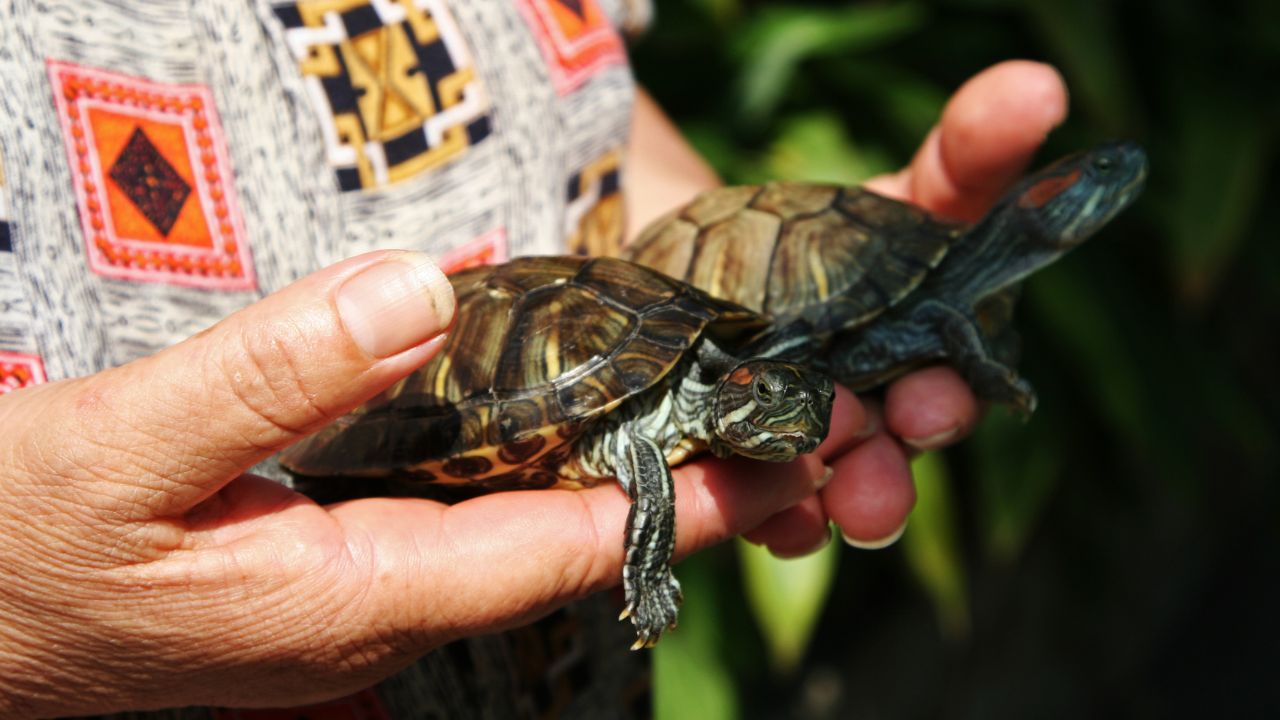Tags:
How To Tame A Turtle Like A Pro?


fact checked & review by
Dr. Partho Kumar Shaha
Veterinarian (DVM)
The information is current and up-to-date in accordance with the latest veterinarian research.
Although turtles are fascinating pets if given the proper attention and care, they need a unique environment in which to thrive. You can learn to tame a turtle like a pro if you put in the time and effort to do so.
A sound and secure setting is essential for successfully taming a turtle. To do this, make sure your turtle has a safe environment that meets its needs in terms of temperature, humidity, food, and water.
The best ways to ensure the happiness and health of your pet turtle are covered in this article. The correct environment, nutrition, and training methods for your turtle will be discussed. You’ll be a turtle-taming pro in no time if you follow these steps and have a little persistence.
Are Turtles Tameable?
A turtle may be tamed. We have the answers to your questions about turtle taming. The reptile is not known for its sociability.
Indeed, they are quite reserved and timid, preferring to keep their distance from other people. Even a tamed turtle is unlikely to get friendly with its human companions, in contrast to dogs and cats.
Even if a turtle is raised with people, it will still shun humans. In contrast, a turtle may be domesticated with the right surroundings, healthy food, and plenty of loving attention.
Your turtle will develop used to you if you are patient and consistent. Although it may take some time, the turtle will eventually get used to you. However, not every turtle will accept its human caretakers.
What Procedures Should You Follow To Tame Your Turtle?
1. Feeding Your Turtle By Hand
The feeding routine is the single most significant factor in successfully domesticating a turtle. The turtle will be more open to you if it learns that you are a reliable source of food. Providing the turtle with regular food helps establish a bond and establishes a habit.
The turtle should be fed daily at the identical time. Do not assume that the turtle will eat out of your palm right away, it will likely still be afraid of you.
However, you may feed the turtle within the cage while keeping an eye on it. Doing so will let the turtle know that you pose no danger to them. The turtle will become used to feeding near you in due time.
After that, you may start feeding the turtle by hand. Keep the meal around five centimeters from the turtle and sit back for it to approach.
This will take a long time, maybe a few months. If your turtle is timid, you may coax it out of its shell with a live cricket or other tasty treat.
2. Pet The Turtle
It may be vital to learn how to properly pet your turtle in order to tame it. You may build trust with your turtle and make it feel more at ease near you by caressing it.
But first, a disclaimer: certain kinds of turtles are solitary by nature and would likely not like being petted.
Some turtles may not like any sort of contact at all, even if they are tolerant of petting. Each turtle, of course, will have its own unique character.
Unlike many common companion animals, turtles do not love being cuddled and petted. Therefore, it’s not easy to pet them. If you want to pet your turtle, here’s what you need to do:
Come up to your pet turtle from its front.
You should approach the turtle while in a visible posture so that it can assess your intentions. The turtle may become aggressive if approached from behind or even from the side, in which case it may bite or otherwise hurt you or itself.
The turtle should notice you coming. Then it will know you’re there and be able to react accordingly.

3. The Turtle Must Be Placed On An Even Surface
Before petting the turtle, make sure it is on a level, flat area. The turtle may be hurt if it fell off a table.
Also, avoid putting the turtle on a carpet and instead put it on flooring or tiles. The floor is the ideal environment for a turtle.
4. Pet The Head To Get Started
The turtle’s head may be touched by placing a finger there. Nose and eye contact should be avoided at all costs.
The next step is to pet the creature’s cheeks and chin. Use your finger to scratch the turtle’s cheeks and chin.
You may go on to massaging the turtle’s neck after it has accepted your touches to its head. The turtle may need some time to become used to you before it will do that.
If the turtle seems to be unhappy, stop caressing its head immediately. The turtle may show discomfort by raising its head and opening its jaws.
If this keeps happening, you shouldn’t touch the turtle’s head. If threatened, the turtle may retreat inside its shell. The turtle does not like being handled.
5. Stroke The Shell
A turtle’s shell is an integral structure of the animal itself. It’s more than simply a shell. The turtle has sensory receptors in the shell. Therefore, the turtle can sense your touch on its shell.
Slowly circling or stroking the turtle’s shell may help it relax. The shell may also be cleaned by gently rubbing it with a soft-bristled brush.
6. The Turtle Should Be Placed On The Lap
Having the turtle sit on your lap allows you a wonderful opportunity to develop a close relationship with it.
Because turtles are able to defecate and urinate, you should cover the area of your lap where the turtle will be sitting with a towel or another piece of fabric. Pay close attention to the motions of the turtle to prevent it from slipping and falling by mistake.
7. Have Patience
Baby turtles that were touched regularly are more likely to like being petted as adults. Older turtles have a reduced ability to learn. Not all turtles are equally responsive.
However, turtles are not often docile pets. You’ll need to be patient with the turtle as it adjusts to being petted.
The time you spend caressing and handling it should likewise be limited. Prolonged touching might be stressful for the turtle if it isn’t used to being around humans.
Feeding turtles is another way they learn to trust people. When you pet the turtle, you may give it a treat. Be cautious not to give the turtle an excessive amount of food.
What Should You Consider While Taming A Turtle?
It’s not common to keep a turtle as a pet. They are harder to tame and much less sociable.
There is a huge gulf between how you treat a dog or cat and how you should treat a turtle. If you’re trying to domesticate a turtle, you should know the following:
1. Salmonella Bacteria Are Carried By Turtles
Turtles have a reputation for being kind and harmless creatures. However, this is often not the case. Salmonella is spread by turtles.
Both the turtle’s shell and its skin may be discovered to harbor this kind of bacterium. Salmonella is harmless to turtles but may be dangerous to people. Salmonella infections may be caused by ingesting the bacteria.
While most individuals infected with salmonella will only have mild symptoms, this illness may be very dangerous for people over the age of 65, young kids, expectant women, persons with low immune responses, and those with gastrointestinal or bowel diseases.
If you want to prevent getting salmonella from stroking your turtle, just rinse your hands well with soap afterward. Salmonella may be carried by turtles even if they are kept in a sterile environment.
Salmonella infections may cause a wide variety of symptoms, including vomiting, stomach pain, nausea, diarrhea, blood in the stool, a headache, chills, and a high temperature.

2. Certain Turtles May Inflict Severe Physical Injury
Although most turtle attacks are harmless, many species have severe and perhaps lethal bites. The alligator snapping turtle and the common snapping turtle are two turtles that have unpleasant bites.
If you attempt to touch a snapping turtle, it might easily rip your fingers off or cut you quite deeply. However, the alligator turtle has been known to amputate fingers.
Its bite is dangerous enough to produce severe wounds on its own. Even the bite of a softshell may hurt. Bite wounds that may cut like a knife.
The bites of map turtles, sliders, and cooters, among others, are not as severe or hazardous as those of other turtles. Before you attempt to touch or tame your turtle, you need to learn about it.
3. Be Gentle With The Turtle.
The turtle is readily harmed by rough or inappropriate handling. For instance, if you try to pick up a turtle by its tail or leg, the turtle might suffer a significant injury. Here are some things to think about when you go about picking up the turtle.
The turtle’s legs and limbs should not be touched. Do not approach the turtle, and especially do not try to pick it up by its legs.
Picking up the turtle is not recommended. Don’t pick it up until you really have to. Since turtles spend all of their time on the ground in nature, raising a small turtle by holding it in the palm of your hand will be less stressful for it.
4. Pick Turtles Up From Behind
If you pick up a turtle by its front end, it may bite you. Therefore, when picking up a turtle, always start from the rear.
Lifting a turtle from the front may cause catastrophic injury, especially if the turtle is a snapper. Lifting a turtle from the rear is the safest and most humane way to handle even the smallest species, such as the softshell turtle.
Turtles are vulnerable to harm despite the durability of their shells. Scratches, bruising, and cuts are common injuries for softshell turtles. It is possible for the shells of even hardshell turtles to be damaged. Careful handling of the turtle is required.
5. Take The Temperature Seriously
Since turtles are cold-blooded, the ambient temperature has a significant impact on how responsive they will be to being touched. The turtle is more prone to hide and avoid being disturbed when the weather is cold.
When warmed up, turtles are significantly more responsive. Even when they are warming themselves with a sunlamp or sun. When the weather is warm, that’s when you should let your turtle outside.
6. Learn When To Give The Turtle Some Space
Turtles are solitary creatures. In most cases, they would rather be alone. You need to learn when to back off while taming your turtle.
Because of their lack of verbalization, turtles’ needs for privacy are often misread. The turtle may not like the following petting attempts:
- If the turtle lunges at you and makes an attempt to bite you, this is an unmistakable indication that it does not want to have any interaction with humans.
- If a turtle is trying to get some peace and quiet, it will often retreat under its shell.
- At you with a hiss.
- Having no expression and staring open-mouthed.
7. It May Take A Year Or More To Successfully Tame Your Turtle
In contrast to canines and felines, turtles are often less receptive to human company. Taming a turtle may be a long and arduous process, particularly if the turtle was not reared in captivity but rather captured from the wild.
It’s far simpler to domesticate turtles that have been raised in captivity from the time they were hatchlings. Be patient, it will be a while before the turtle recognizes you and warms up to you.
What Are The Ways To Make A Turtle Feel Comfortable In Its Tank?
Make sure your turtle’s environment is comfortable for it to feel secure in and start the taming process. Create places where individuals may hide. The turtle’s hiding places are off-limits, so be careful. The turtle may take refuge here whenever it feels threatened.
Having a safe area to escape to in case of danger reduces the turtle’s stress levels. It’s easy to create a secure area.
You may purchase a hide from a retailer like Reptile Habitat Cave. In addition to that, you may utilize a pot made of clay as a hide. To get access, just invert the container.
Restrict your social activity to a minimum.
Because of their reclusive nature, turtles need little human contact. Don’t bother the turtle when it’s sleeping, for starters.
Do not bother the turtle if it has gone into hiding. Only approach the turtle while it is out in the open for its normal behaviors, such as feeding, basking, or interacting with its peers. If you keep bothering the turtle, it won’t take your taming efforts seriously.
Is It Hard To Tame A Turtle?
In most cases, a turtle is difficult to train. Unlike dogs, turtles don’t thrive in group settings.
As a result, they prefer to be on their own. But the turtle may become habituated to you if you engage with it often. The turtle will eventually come up to you if you approach its cage.
Because of their familiarity with humans, wild turtles might be more challenging to tame. It will be much simpler to domesticate a turtle if it is reared by humans from the time it is a baby.

Can A Wild Turtle Be Kept As A Pet?
Having a wild turtle as a pet is not recommended. To begin with, it’s obvious that the turtle has never been in such a little space before.
The turtle will experience significant stress due to the relocation. Turtles in the wild have not yet developed a taste for the items that will be provided to them.
The turtle probably won’t like people either. Most wild turtles struggle to adjust to domestic life. In certain areas, it is also forbidden to keep wild turtles as pets.
Conclusion
Keeping a turtle as a pet is challenging. This is due to the fact that they are solitary animals. A turtle may seem untamable at first, but with time and effort, you may teach it to comply.
If you want to successfully tame your pet turtle, you must avoid overdoing it. You should not spend more than 20 minutes every day together. Hand-feeding a turtle is the most effective method of taming it. Taming your turtle via petting is another option.
If you are interested in learning to train a tortoise then check out – Can You Train A Tortoise? [Easy Guide]

About Author
Muntaseer Rahman started keeping pet turtles back in 2013. He also owns the largest Turtle & Tortoise Facebook community in Bangladesh. These days he is mostly active on Facebook.
Disclaimer
This site is owned and operated by Muntaseer Rahman. TheTurtleHub.com is a participant in the Amazon Services LLC Associates Program, an affiliate advertising program designed to provide a means for sites to earn advertising fees by advertising and linking to Amazon.com. This site also participates in other affiliate programs and is compensated for referring traffic and business to these companies.
